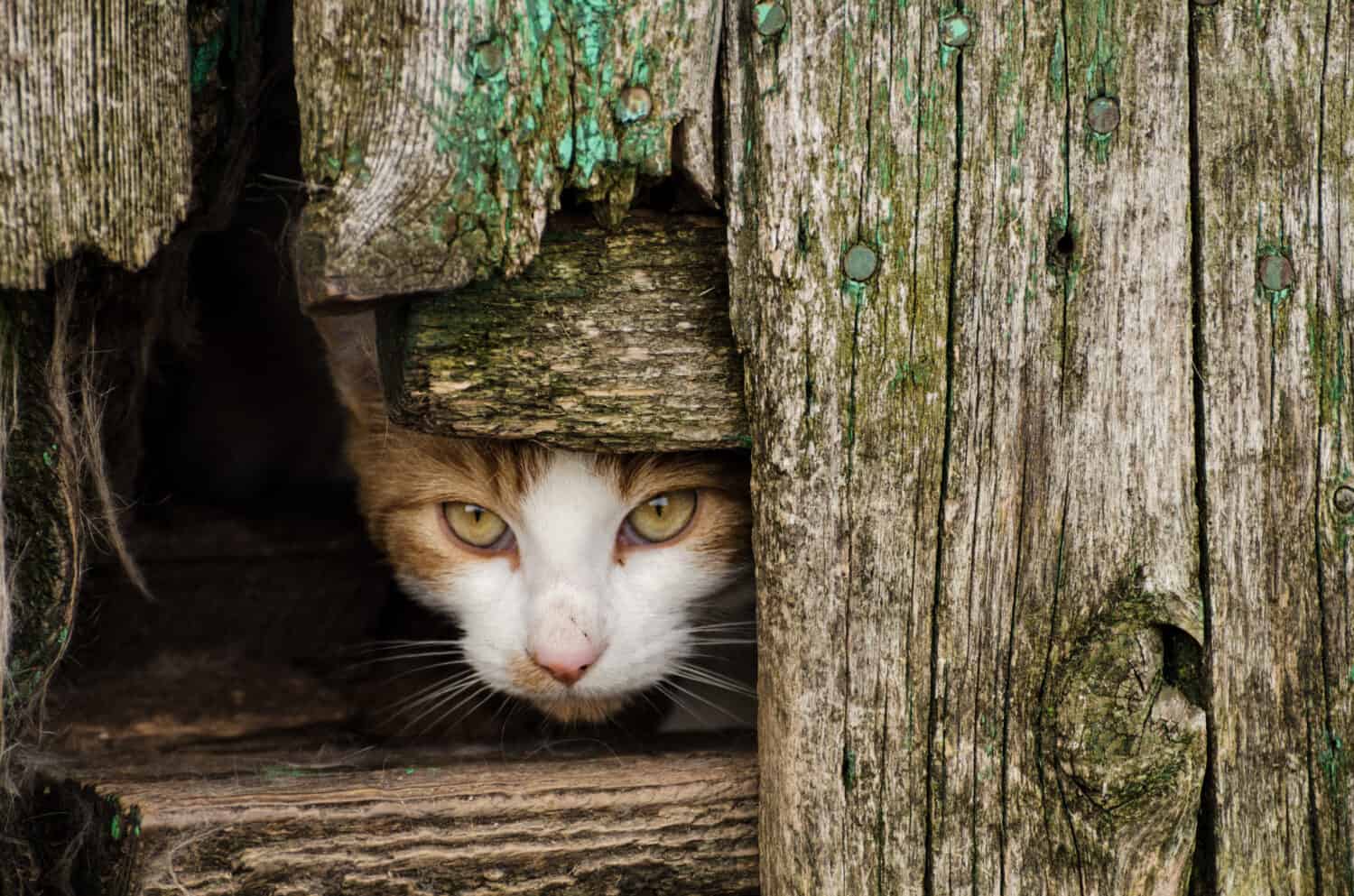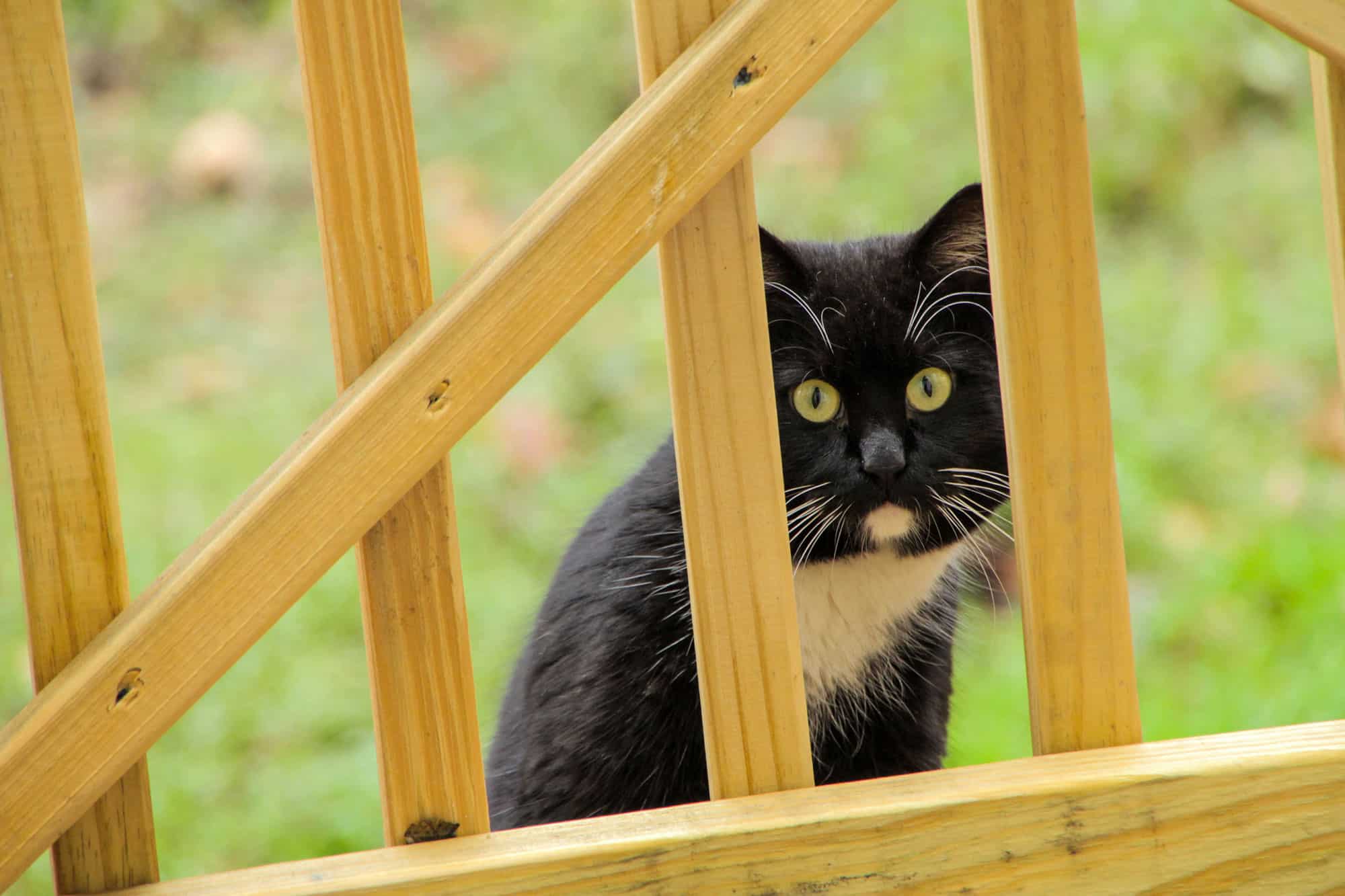As the saying goes, “Don’t feed strays, they will come back.” And, unfortunately, this is the reality. If you happen to notice that the stray cats in your neighborhood have begun to increase in number or just generally overstay their welcome, this article is here to tell you the best ways to get rid of stray cats in a way that is humane, and empathetic. Just because you don’t want the responsibility of providing for these creatures doesn’t mean that you wish them ill will- sometimes that’s just life. In this piece, we’ll show you how to repel stray cats naturally, efficiently, and safely.

Understanding Stray Cats and Why They Come to You

Stray cats are cats that have had human interaction before (at least to some degree). Feral cats are ones that have grown up entirely in the wild and have an aversion to or fear of people.
©anutr tosirikul/iStock via Getty Images
Before we can get into the ways in which you can get rid of stray cats that approach or surround your home, you need to understand why they come sniffing around in the first place. Stray cats will come to you for a number of reasons, but the most substantial is because they believe you can provide them with basic necessities of food, water, and shelter.
Stray cats are often drawn to areas where food is readily available. People who leave pet food outside inadvertently attract stray cats, even if that food was intended for their own animals. Those cats can’t tell the difference, and they surely don’t care! The same goes for easy access to water- that birdbath can make for a perfect drinking fountain.
Another reason stray cats could be particularly attracted to your home? They sense that you don’t really mind. Cats are adept at sensing people’s dispositions, and if they (especially those with previous human interactions) can tell that you are kind-hearted and willing to share your resources with them, they will be even more inclined to stick around.
As nice as it is to have some extra furry friends, it’s important you understand the implications of being too welcoming to strays. Cats breed in abundance, and one can turn into ten in as little as a few months. You must take the responsibility that comes with willingly providing for these strays. Your behavior has a long-term impact on the cats and your community.
Stray Vs. Feral Cats
If you’re someone with intentions of helping, rehoming, or even taking in a cat that you find outside, it’s imperative that you recognize the difference between a stray cat and a feral cat. Now, the term “feral” has some negative connotations that are not true. No, feral cats aren’t going to have rabies or attack you on sight, but the fact is that they have had little to no human interaction in their entire lives. This, of course, will make them quite frightened of you; they may even be aggressive.
A feral cat, which has been born and raised in the wild, is simply unlikely to embrace domestication. You might think that you’re doing feral cats a favor by taking them in or finding them a home through a rescue, but they may actually be much happier in their natural environment. Should you find a feral cat, you can always refer to the Trap-Neuter-Return method (which we’ll elaborate on in detail later), or you can just try your best to allow the cat to live independently without your interference.
You’ll typically be able to tell the difference between a stray cat and a feral one within your first few interactions. As always, take caution when interacting with any animal you happen upon outside. Even if you’re well-intentioned, the animal you’re dealing with might not understand that.
Natural Deterrents and Repellents

If you sprinkle substances that stray cats hate the smell of in areas that they frequent, you can help to discourage them from coming around your home.
©Katamount/Shutterstock.com
If you want to get rid of stray cats naturally, you have quite a few options. Felines are cautious creatures that scare easily, so there are many ways to deter them without worrying about bringing them any kind of real harm. Here are some basic methods of repelling stray cats that aren’t much work:
- Install some motion-activated sprinklers. Cats, as you may know, are not the biggest fans of getting wet. You should also move the sprinklers around a bit every few weeks. That way, they won’t get used to the water being in one specific area.
- Plant some green onions every few feet or so in your garden. This is a double-whammy because cats hate them, but they make an excellent addition to most human meals!
- This is a bit far-fetched (get it, fetch?) but get a dog! And, if you have a dog, use him or her to your advantage. Even the sight of a large predator, or the recognition that there’s one around, can be enough to get rid of the stray cats.
- Create a solution that is part water and part white vinegar. Every day, take a few minutes to spray down the areas that the cats are most attracted to. They’ll become uncomfortable and will be less inclined to visit this spot in the future.
A Word of Warning
There are some people who do things to get rid of stray cats that are quite unsavory. These include harmful, horrific things such as scattering broken glass or hiding barbed wire. This is unacceptable, inhumane, and entirely unadvisable. Not to mention, it is illegal to deliberately wound a domestic cat.
Scent-Based Repellents
In addition to the previous recommendations, there are also some specific scents that cats simply cannot stand. By scattering any of the following items around your yard, you’ll be able to successfully get rid of stray cats that were previously interested in the area. Here are some of those things:
- Orange/Lemon Peels
- Cayenne Pepper
- Coffee Grounds
- Tobacco
- Chili Pepper Flakes
- Lavender Oil
- Citronella Oil
- Peppermint Oil
- Eucalyptus Oil
With these, like all deterrents, there is an important consideration. If you have your own cats running about, don’t let them near these items. They’ll hate it just as much as the strays!
Modify The Area

If the stray cats that frequent your home no longer have shelter to stay in, food to eat, or water to drink, they’ll very likely find somewhere else to shack up.
©Julie Marshall/Shutterstock.com
Another effective way to get rid of stray cats, or at least make your home less appealing to them, is to modify the parts of your property that seem to keep them coming back. The most obvious of these is to no longer leave accessible food and water sources outside. However, there are actually more detailed steps you can take to make sure they want nothing to do with your home.
The first method is securing your trash bins. Cats love to eat, and garbage is no exception. Here are a few tips for making your garbage less accessible:
- Use bins with tight-fitting or lockable lids.
- Place heavy objects on top of bin lids.
- Store bins in a secure area, like a shed or a garage.
This next one might seem a bit cruel to some, but the truth is that it serves a functional purpose. This is the act of sealing off any potential shelter. This isn’t to expose these cats to the elements, of course. It is to encourage them to find somewhere to stay that isn’t right outside of your home. This way, you can avoid the strays establishing a territory within your property and especially avoid them beginning to nest and give birth there. Here’s how to make sure you have your bases covered:
- Seal off spaces underneath porches, decks, and sheds.
- Keep garage and shed doors closed.
- Install cat-proof fencing around yards and gardens.
Trap-Neuter-Return Method (TNR)

Cats breed often and in large quantities. Making sure that they’re neutered/spayed, stray or otherwise, is highly important.
©iStock.com/bozhdb
A widely encouraged process for stray cats is the Trap-Neuter-Return (TNR) method. The process is pretty self-explanatory, but here it is broken down in more depth:
Trap: Stray and feral cats are trapped using humane, live traps.
Neuter: Trapped cats are then spayed or neutered by a veterinarian to prevent reproduction.
Return: After recovery, the cats are returned to their original locations.
Sometimes, a cat that grew up in the wild would like to live out the remainder of its life in nature. That isn’t necessarily a bad thing, especially if it isn’t causing a spike in the local feral cat population. By using the TNR method, you can ensure that this cat won’t continually give birth to kittens. Instead, it can independently live out its life in the area it knows best.
There are other benefits to TNR besides population control, though. For instance, neutered cats are less prone to diseases and live healthier lives, reducing the spread of feline diseases in the community. When cats get neutered, it also reduces aggressive behaviors in cats like fighting, yowling, or spraying. Generally, having any cat spayed/neutered, regardless of whether a housecat or a cat in nature, is going to be better for their health and the community’s health.
Encourage Responsible Pet Ownership

Microchipping your cat is important because it’s a guaranteed way that they will find their way back to you if they ever become a stray themselves.
©Lucky Business/Shutterstock.com
There are many responsibilities that we have to animals. We might not have these responsibilities to all animals in existence, but to a degree, these responsibilities exist between us and any animal that enters our lives. That is why it is of the utmost importance that you take the necessary steps to care for animals that cross paths with you, especially animals that are a part of your family.
A large number of stray cats have had homes before. Some have been dropped off or abandoned, but some have also simply gotten lost. Always be sure to microchip your pets and have them wear a collar with identifiable information in the instance that they get lost. This is a great way to prevent your precious feline from becoming inadvertently abandoned. Cats that are obvious pets are the ones that are most likely to get the attention and help they need from strangers, as they know for certain that the cat has a home to get back to.
Understand that when you do things like feed stray animals, you are confusing them. You are encouraging them to return, and if you don’t continue to provide for them as you had in the past, they may feel even more abandoned. It is only human to have the inclination to help a creature that you believe needs this assistance, but try to have the foresight to recognize an unadvisable situation when it greets you.
Thank you for reading! Have some feedback for us? Contact the AZ Animals editorial team.








